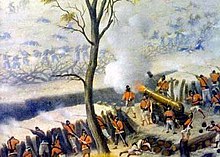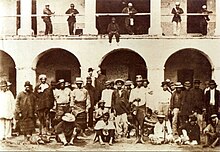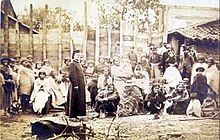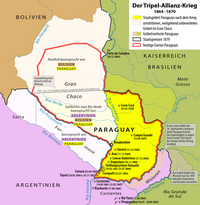Triple Alliance War
| date | 1864 to 1870 |
|---|---|
| place | South America |
| output | Allied victory, complete defeat of Paraguay |
| Parties to the conflict | |
|---|---|
| Commander | |
|
|
|
| Troop strength | |
| 150,000 soldiers | 164,173 Brazilians, 30,000 Argentines, 5,583 Uruguayans, total: 199,756 soldiers |
| losses | |
|
approx. 300,000 soldiers and civilians |
around 125,000 soldiers, including 100,000 Brazilians, 20-25,000 Argentines and 3,000 Uruguayans |
1st phase: Paraguay's offensives against Brazil and Argentina (1864–1865)
Mato Grosso campaign - Corrientes - Riachuelo - Yatay - Uruguayana
2nd phase: Allied counter-offensive and
trench warfare before Humaitá (1866–1867) Itapirú - Estero Bellaco - Tuyutí I - Yataytí Corá - Boquerón - Sauce - Curuzú - Curupaytí
3rd phase: resumption of the Allied offensive and conquest of the heartland of Paraguay (1867–1868)
Tuyutí II - Humaitá - Ytororó - Avahy - Itá Ivaté
4th phase: Final Allied offensive and total defeat of Paraguay (1869–1870)
Piribebuy - Acosta Ñu - Cerro Corá
The triple alliance war ( Spanish Guerra de la Triple Alianza ) is the name of the fight between Paraguay and the allied states Argentina , Brazil and Uruguay , which lasted from 1864 to 1870 . Paraguay initially stood on the side of the conservative government of Uruguay, which was overthrown in the Uruguayan War with Brazil's support in 1865.
The war ended with the complete defeat of Paraguay and is considered to be the bloodiest conflict in Latin American history. In Europe he went largely unnoticed.
In Paraguay it is also called the “Great War” ( Guerra Grande ) or “War against the Triple Alliance” ( Guerra contra la Triple Alianza ), in Argentina, Brazil and Uruguay it is called the “Paraguayan War” (Portuguese Guerra do Paraguai ; Spanish Guerra del Paraguay ).
The Triple Alliance
After the government of Uruguay, who was friends with him, was overthrown by the influence of Brazil and Argentina, the dictator of Paraguay, Francisco Solano López , began a war of conquest against Brazil in December 1864 in order to gain access to the sea.
At the instigation of Uruguay's head of state Venancio Flores , the Triple Alliance was decided in a secret treaty on May 1, 1865 : the alliance of Brazil, Argentina and Uruguay against Paraguay, which lasted until the end of the war in 1870. Further support came from France and Great Britain, who (like Spain) used the US Civil War (1861–1865) as an opportunity for new interventions in America (Spain, however, was involved in the Callao War with Peru, Bolivia, Chile and Ecuador).
Although the tide soon turned against Paraguay, López was not ready to surrender. In the end, the war and the epidemics it triggered killed around three quarters of Paraguay's population.
procedure
Causes of War and Start of War
In April 1863, Venancio Flores , leader of the Liberals ( Colorados ) in Uruguay, sparked an uprising against the government controlled by the Conservative Party ( Blancos ). Flores could count on the support of Brazil and Argentina, where he had fought alongside the victorious President Bartolomé Miter in the civil war that ended in 1861 . The Uruguayan government, in distress, turned to Paraguay for help, which played an important role in the region thanks to its large and well-trained army for the time and a progressive economy. The dictator Francisco Solano López had ruled Paraguay since 1862 . López saw the regional balance of power disrupted and sided with Blancos. He feared that if the Brazilians and Argentines were successful in Uruguay, they could then take this pattern against his rule in Paraguay. When Brazil rejected López's attempts to mediate in the conflict, on August 30, 1864, he demanded that the Brazilian government finally put an end to interference in Uruguay. The document in question made it clear that Paraguay would consider an occupation of Uruguayan territory by Brazilian forces as a casus belli .
When the Brazilians nevertheless began to blockade Montevideo and to land troops in October 1864 , López had the Brazilian ship Marquêz de Olinda on the Paraguay River seized in retaliation the following month , and his crew and the governor of the province of Mato Grosso on board were captured and declare war on Brazil on December 13, 1864. Paraguayan troops under Vicente Barrios and Francisco Isidoro Resquin invaded the Mato Grosso that same month; they met with little resistance and took the small fort of Nova Coimbra and, in January 1865, Corumbá . Another Paraguayan combat force was operating successfully at the same time in what is now the Brazilian state of Rio Grande do Sul . The low resistance of the Brazilians was mainly due to the fact that they had concentrated their only small army mainly in what they saw as the much more important theater of war, Uruguay. There they were successful. On February 20, 1865, they were able to conquer the capital, Montevideo, and appoint Flores as president. With that the war in Uruguay was already lost for the side supported by Paraguay.
In order to be able to confront the Brazilian troops in Uruguay, López demanded the right to march through the Argentine province of Corrientes from the Argentine President Bartolomé Miter . Argentina, which officially declared itself neutral in the war but actually allowed Brazilian warships to pass through national waters, rejected this request. Subsequently, on March 18, 1865, Paraguay declared war on Argentina.
The further course of the war
López's troops initially penetrated both south and south-west Brazil and the Argentine province of Corrientes quickly and took the city of Corrientes in April 1865 . The main reason for Paraguay's initial successes was that its standing field army was not only well trained, but also with a total strength of 38,173 men against the opponents, who at first could not muster more than 28,000 men (Brazil 17,600, Argentina 6,000 and Uruguay up to 4,000) were sometimes stationed far away from the future battlefields, and was clearly numerically superior. The key factor for the future was not how many soldiers the warring factions had under arms at the beginning of the war, but what reserves they could fall back on or how many people they could mobilize. Here, however, the balance was clearly to the disadvantage of Paraguay, although its reserves are estimated at up to 150,000 men, which is said to have been around a third of the total population. In comparison, however, only Argentina, the "smaller" of the two "great" opponents of the war Paraguay, could fall back on 184,478 men who were combined in the Guardia Nacional in early 1865 .
When Brazil, Argentina and Uruguay signed the Triple Alliance Treaty on May 1, 1865 for the purpose of joint warfare against Paraguay, in which they undertook to continue the war until López was overthrown, a decisive political turning point to the disadvantage of Paraguay had occurred. With regard to human and material resources, the country was now faced with an overwhelming superiority, which had also been bundled by the Alliance Treaty and which was to prove decisive for the further course of the war. For Paraguay, the character of the war changed from aggressive war to pure defensive war by mid-1865 at the latest, and for Francisco Solano López to the struggle for political survival.
First, however, failed in May 1865 an attempt by the allies to retake Corrientes by surprise, whereupon they established a base just south of the mouth of the small river Riachuelo for their river forces, which were provided here exclusively by Brazil. The attack of the Paraguayan Navy, commanded by Pedro Ignacio Meza , on the Brazilian river forces ended on June 11, 1865 with a momentous defeat in the Battle of the Riachuelo . The Navy of Paraguay lost four of the nine steamships used here and all seven cannon-equipped barges .
Before the Allies could go on the offensive for their part, they had to force and silence the Paraguayan bank batteries south of Corrientes, which finally succeeded in August 1865. In the same month, the López troops suffered another defeat when one of the two army units operating in the south on the Rio Yatay , a tributary of the Río Uruguay , was defeated by Venancio Flores; the other unit was trapped by the Allies at Uruguayana and finally surrendered in September 1865. With these defeats, the strategic initiative was finally passed to the Allies, who now started a counter-offensive and were preparing to invade Paraguay. López ordered the withdrawal of all Paraguayan army units still on enemy territory to their homeland and also had his now too exposed positions in the province of Itapúa evacuated.
Supply problems, disagreement in the Allied High Command and the summer climatic conditions in the area along the Río Paraná , which the Allies had to cross for an invasion of Paraguay, initially delayed their counter-offensive until April 1866. The Paraguayan army used this time between the end of 1865 and spring 1866 to an intense guerrilla war in which they tried by repeated raids to disturb the allies preparing on the south bank of the Rio Paraná, inflict losses on them if possible and shake their morale.
After the Brazilian Navy, in cooperation with army troops, succeeded in capturing Fort Itapirú, which ruled the confluence of the Río Paraguay into the Rio Paraná, the bulk of the Allied troops - around 47,000 men under Mitre's command - took over the Rio Paraná and began the invasion of Paraguay. The Paraguayan army tried to remove the bridgehead they had formed in the Battle of the Estero Bellaco , which, however, failed with great losses. As a result, the Paraguayans withdrew into newly built defensive lines along the Rio Estero Bellaco del Norte. The attempt made from here by the Paraguayan troops to stop the slow advance of the Allies by attacking their main camp (34,700 men) ended on May 24, 1866 with a heavy defeat in the First Battle of Tuyutí . The Paraguayan army lost up to 13,000 - the figures vary widely and, like those on the total strength of the Paraguayan army, are sometimes even higher - of the total of 18,000–24,000 soldiers deployed through death and imprisonment, including their best soldiers. However, the Allies subsequently failed to take the initiative, which enabled the Paraguayans to regroup and mobilize replacement forces. They withdrew again now, in the direction of the fortress complex Curupaiti - Humaitá on the Río Paraguay.
The Brazilian fleet ruled the Río Paraná and the lower reaches of the Río Paraguay with its strong artillery since the beginning of 1866, which is why the Paraguayans were cut off from the connection to the Atlantic. The Allied plan was to advance across the Río Paraguay to the capital of Paraguay, Asunción , which lies on this river. To do this, they first had to take the strong fortress Humaitá and the forts Curupaiti and Curuzú to the south, which ruled the river. Curuzú fell in early September 1866, but the battle of Curupaytí , in which the Brazilian Navy once again supported the Allied land troops, ended on September 22, 1866 with a heavy defeat, which resulted in the loss of around 4,000 of the 20,000 Allied soldiers deployed. The victory, which was achieved with only minor Paraguayan losses, delayed the advance of the Allies, but otherwise did not bring about any significant change in Paraguay's military situation.
After the defeat at Curupaytí, there was considerable war fatigue, especially in Argentina, but also in Brazil and Uruguay. The Allied armies, like the Paraguayans, suffered from disease and had an increasing number of deserters . In February 1867 Miter had to return to Buenos Aires because of domestic political difficulties . The Brazilian general Luís Alves de Lima e Silva, who later became Duque de Caxias, took command of the allies . Although there were repeated contacts in the course of the war with the aim of ending the hostilities, all these attempts ultimately failed because López was unwilling to resign. Even members of his family who tried to convince the president that the war was futile, including his brothers and brother-in-law, were executed. López had his seventy-year-old mother and two sisters flogged.
Only after Brazilian steamers succeeded in overcoming the last Paraguayan river barriers at Humaitá in February 1868, eliminating the remaining Paraguayan river forces and bombarding Asunción for the first time on February 24th, did the crew of the bitterly defended fortress Humaitá have to face themselves in July of the same year bow to Allied pressure and surrender. The way to Asunción was finally open to the Allies.
In December 1868 there was the last great battle of the war near Lomas Valentinas not far from Asunción. Both sides suffered heavy losses; in the end the Paraguayan armed forces were destroyed. López had to give up the capital Asunción and withdraw to the north. On January 1, 1869, a Brazilian contingent of troops under Hermes Ernesto da Fonseca, the father of the future President Hermes Rodrigues da Fonseca , entered Asunción. On January 5, Caxias followed with the rest of the troops. López did not want to surrender, however, offered children and old people and moved the capital to Piribebuy .
In the final phase of the war, on March 22, 1869, Gaston d'Orléans, Count of Eu , the son-in-law of the Brazilian emperor, took over the supreme command of the Allied forces. He proved himself a capable commander and brought the war to a victorious end. Piribebuy fell in August 1869. The Allied troops rushed the remnants of López's army through Paraguay, where López was able to gather a few thousand fighters in the northeast of the country. On March 1, 1870, the remnants of this “last contingent”, no more than a few hundred men, were attacked by a far superior Brazilian force near Cerro Corá on the Aquidabán River and López was killed when he did not allow himself to be captured.
Outcome of the war
Assignments of territory
In the peace treaty of June 20, 1870 Paraguay had to cede around 144,000 km², around 50 percent of its national territory, to Brazil and Argentina. Argentina reacquired the Misiones region , which had previously been occupied by Paraguay, and part of the Chaco region between the Bermejo and Pilcomayo rivers . Brazil struck the won territories of its province (later state) Mato Grosso ; after the division of Mato Grosso in 1979, the area is now part of the Brazilian state of Mato Grosso do Sul .
The last Brazilian occupation troops withdrew from the rest of Paraguay in 1876.
Number of victims in Paraguay
The war of Paraguay against the Triple Alliance is - measured by the victims of Paraguay in relation to its total population - one of the war with the most losses in world history. It is estimated that Paraguay's population was reduced from just over 500,000 to around 221,000 in the course of the war. The information given by the pre-war population is controversial. The 1846 census showed 238,862 inhabitants, although some districts were left out and the total number of children was underestimated. The Belgian chronicler Alfred DuGraty spoke in his book of a million inhabitants, a controversial census from 1857 even showed 1,337,439 inhabitants. At the end of the war, the population of Paraguay consisted mainly of women and children, as only around 28,000 adult men had survived the end of the war, which corresponds to a loss of up to 80 percent in the male population. Since thirteen to sixteen year olds were drafted into the Paraguayan army since 1867 and people up to 70 years of age were also called up for military service, the population loss was not limited to the group of adult men, but went through almost all age groups. Women also took part in the fighting in the final stages of the war.
Since 1869 at the latest, the Allied forces have been waging a relentless war against the civilian population. There was widespread looting and rape. Refugee movements made the population loss even higher.
Political Consequences
Paraguay, which before the war was one of the most economically advanced and powerful states in the region, was never able to regain this status. In Paraguay, the memory of the war is still alive today and is part of the national myth. The then President López is heroized by official bodies. Patriotism and the cult of sacrifice, especially with regard to child soldiers, are the focus of Paraguay's culture of remembrance.
The Argentine government experienced a noticeable consolidation through the victory.
In Brazil, anti-monarchist elements were strengthened in the officer corps, which criticized the leadership in the long-drawn-out war. Likewise, the opponents of slavery, at that time the most important pillar of the Brazilian economy and society, were strengthened, as numerous slaves served as volunteers in the army during the war.
The Paraguayan Legion
After the outbreak of war, members of the Asociación Paraguaya, who were in exile, formed the Legión Paraguaya . The leaders of the Legionarios were Juan Francisco Decoud and Fernando Iturburu. It was not until March 20, 1869, shortly before the end of the war, that General Emilio Miter allowed them to fight as a separate unit under the Paraguayan flag. Most of the Legionarios returned to Paraguay after the war ended and secured positions of influence. To this day, members of the Liberal Party are disparagingly referred to as legionaries by the Colorados , although 23 of the Colorado Party's founding members were also former members of the Paraguayan Legion.
cards
literature
- Source editions and memoirs
- Richard Francis Burton: Letters from the Battlefields of Paraguay. Tinsley Brothers, London 1870.
- George Thompson: The War in Paraguay. With a Historical Sketch of the Country and Its People and Notes Upon the Military Engineering of the War. Longmans, Green and Co., London 1869.
- Secondary literature
- Heinz Joachim Domnick: The War of the Triple Alliance in German Historiography and Journalism. , Frankfurt a. M. 1990, ISBN 3-631-42577-5 .
- Gabriele Esposito: Armies of the War of the Triple Alliance 1864-70: Paraguay, Brazil, Uruguay & Argentina (= Men-at-Arms, Volume 499). Osprey Publishing, 2015. ISBN 978-1-4728-0725-0 .
- Hendrik Kraay and Thomas Whigham (eds.): I Die with My Country: Perspectives on the Paraguayan War, 1864-1870 (= Studies in War, Society, and the Military). University of Nebraska Press, Lincoln et al. a. 2004, ISBN 978-0-8032-2762-0 .
- Chris Leuchars: To the Bitter End. Paraguay and the War of the Triple Alliance (= Contributions in Military Studies). Greenwood Press, Westport 2002, ISBN 978-0-313-32365-2 .
- Jürg Meister: Francisco Solano Lopez - national hero or war criminal? The War of Paraguay against the Triple Alliance 1864–1870 . Osnabrück 1987, ISBN 3-7648-1491-8 .
- Siân Rees: Elisa Lynch. The True Story of an Irish Courtesan and How She Became Paraquay's Most Powerful Woman. Europa Verlag, Munich 2003, ISBN 3-203-81501-X .
- Thomas L. Whigham: The Paraguayan Was. Vol. 1: Causes and early conduct (= Studies in War, Society, and the Military). Univ. of Nebraska Press, Lincoln et al. a. 2002, ISBN 0-8032-4786-9 .
- Thomas L. Whigham: The Road to Armageddon. Paraguay Versus the Triple Alliance, 1866–70 (= Latin American & Caribbean Studies 14). University of Calgary Press, Calgary 2017, ISBN 978-1-55238-809-9 .
- Articles in newspapers and magazines
- Diego Abente: The War of the Triple Alliance. Three Explanatory Models (PDF; 2.4 MB). In: Latin American Research Review , Vol. 22, Issue 2 (1987), pp. 47-69.
- Leslie Bethell: The Paraguayan War (1864-1870) (= University of London. Institute of Latin American Studies. Research Papers, 46). London 1996, ISBN 1-900039-08-7 .
- Ralph Rotte : Paraguay's "Guerra Grande" against the Triple Alliance, 1864-1870 (= RWTH, Institute for Political Science, Discussion Paper No. 33) August 2009, ISSN 1862-8079 (34 pages with maps).
- Ralph Rotte: Paraguay's fight against the Triple Alliance 1864 to 1870. In: Military history. Journal of Historical Education, Issue 1/2010, pp. 8–11.
Web links
References and comments
- ↑ a b c d Ralph Rotte: Paraguay's fight against the Triple Alliance 1864 to 1870 , in Military History, Issue 1/2010, pp. 8-11.
- ↑ Whigham (2002), pp. 167, 172 and 187. - The number 38,173 comes from an official Paraguayan source from the beginning of 1865 and, according to Whigham, should come relatively close to reality. Thompson (1869), p. 52, gives 80,000 men for the Paraguayan army, of which a third is said to have been the cavalry. Overall, however, there is considerable confusion in the literature with regard to the army strengths of the conflicting parties, because the figures mentioned often do not differentiate between standing army and militia-like national guards or the individual branches of service. See also the figures in Abente (1987), p. 55, Table 1: Regional Power Capabilities of Paraguay, Argentina, Brazil and Uruguay circa 1860 (PDF; 2.4 MB).
- ^ Whigham (2002), p. 187.
- ^ Whigham (2002), p. 172.
- ^ A b Adrian J. English: Armed Forces of Latin America. Their Histories, Development, Present Strength and Military Potential. Jane's Information Group, 2nd ed., London 1985, ISBN 978-0-7106-0321-0 , pp. 346f. and 354. - According to other estimates, only around 116,000 Paraguayans survived the war.
- ↑ Holocausto paraguayo en Guerra del '70 abc.com.py , September 26, 2009, accessed October 23, 2018.
- ↑ International Bureau of the American Republics (ed.): Paraguay. A handbook. Washington, DC 1892, p. 37.
- ^ R. Andrew Nickson , Historical Dictionary of Paraguay, The Scarecrow Press, Metuchen & London, 1993, ISBN 0-8108-2643-7 .












